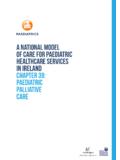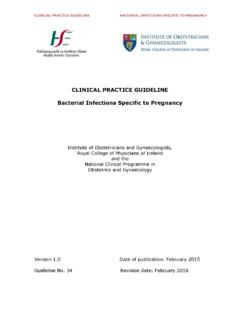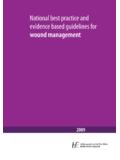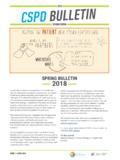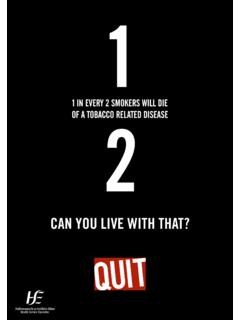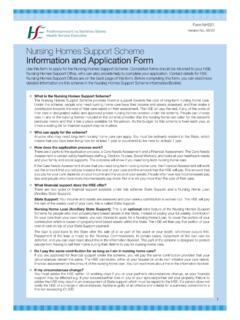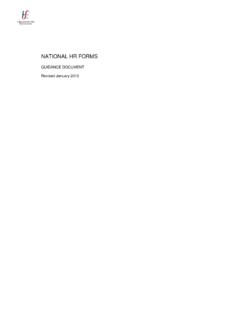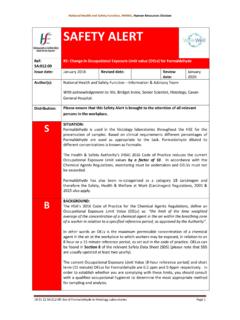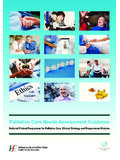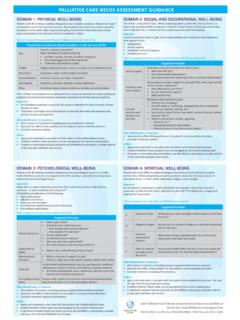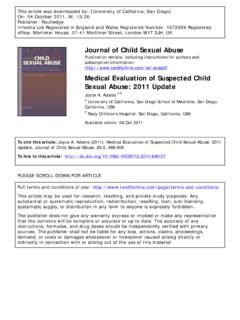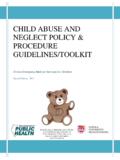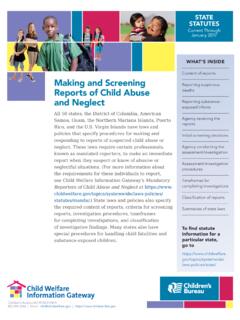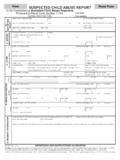Transcription of A National Model of Care for Paediatric Healthcare ...
1 A National Modelof care for PaediatricHealthcare Servicesin IrelandChapter 16:ChildProtectionClinical Strategy and Programmes DivisionTable of Introduction Current Service Provision 3 Current services for children with inflicted injury/neglect/emotional abuse in ireland 3 Current child Sexual Assault services for Children in ireland Proposed Model of care 6 Model of care for Physical Abuse/Inflicted Injury/Neglect/Emotional Abuse 7 Model of care for Historical child Sexual Abuse 8 Model of care for Acute child Sexual Assault 8 Other Resources 9 Vulnerable Children and Serious Case Reviews Requirements for Successful Implementation of Model of care 9 Organisation-level Requirements 9 Staffing Requirements 10 Governance 11 Education and Training 1116. 4 Programme Metrics and Evaluation 1116.
2 5 Summary Key Recommendations Abbreviations References 131national Clinical Programme for Paediatrics and neonatology:a National Model of care for Paediatric Healthcare services in InTroduCTIonAll children and young people have a right to be protected from child abuse and neglect. child protection is a very important aspect of paediatrics, and all doctors have a duty to protect children. However, the historical neglect of this area of Paediatric health service development means that the service in ireland is under-resourced and difficult to navigate, leaving the most vulnerable children in society at risk. child protection is a complex and demanding area, which requires the involvement of many hospital, community health and non-health multidisciplinary agencies and services .
3 A National strategy addressing the child protection needs of children who present with inflicted injury, neglect, emotional abuse or child sexual abuse is the cornerstone to improving the delivery of care to a level that reaches best practice standards. The formulation of this strategy will require consultation with the Health Service Executive (HSE) and Tusla, the child and Family protection referrals to paediatricians have traditionally been divided into the following subtypes: physical abuse/inflicted injury including head injuries, burns, and fractures neglect emotional abuse factitious or induced illness child sexual abusebackground Informing best Practice for child ProtectionIt is internationally accepted that child abuse and neglect is a major public health issue. In 2012, there were 19,044 child protection and welfare referrals to social work departments in ireland for initial assessment.
4 The number of referrals had increased year on year from 2006, when there were 9,461 referrals (Tusla, 2014). A report by the Department of Children and Youth Affairs, State of the Nation s Children: ireland 2012, revealed that at the end of 2012 there were over 6,300 children in the care of the state, 2,070 of whom entered into care that year (DCYA, 2012). In 2009, there were 2,500 reports of child sexual abuse to social work departments across ireland (HSE, 2011). The 2002 Sexual Abuse and Violence in ireland (SAVI) study of over 3,000 adults reported that one in four of those interviewed had experienced sexual abuse in childhood. Almost half (47%) reported that they had never previously disclosed the abuse to others, indicating that the figures may actually be much higher (McGee et al., 2001). Few suspected cases of child abuse result in criminal prosecution or a Irish Medical Council s Guide to Professional Conduct and Ethics for Registered Medical Practitioners (IMC, 2009) states that all doctors should be aware of the National guidelines for the protection of children.
5 It also states that any doctor who has concerns regarding alleged or suspected sexual, physical, emotional abuse or neglect of children must report this to An Garda S och na (Withholding of Information on Offences Against Children and Vulnerable Persons Act 2012) and/or the relevant statutory agency (Tusla) without delay. Tusla was established on 1 January 2014, and is responsible for improving the well-being of children and ensuring best possible outcomes for them. Children First: National Guidance for the Protection and Welfare of Children was first published in 1999, and subsequently revised in 2011 (DCYA, 2011). This document promotes the protection of children from abuse and neglect, and outlines what different statutory and non-statutory bodies, and the general public, should do if they are concerned about a child s safety and welfare.
6 Although Tusla and An Garda S och na are the two bodies with statutory responsibility for child protection and welfare, the document outlines the significant role that paediatricians play in protecting children. It also emphasises the importance of multidisciplinary and interagency working in which paediatricians play a vital role. 2national Clinical Programme for Paediatrics and neonatology:a National Model of care for Paediatric Healthcare services in IrelandIn 2012, the Health Information and Quality Authority (HIQA) developed the National Standards for the Protection and Welfare of Children to support continuous improvements in the care and protection of children in receipt of HSE child protection and welfare. The Standards recommend that children should be supported through the provision of accessible information and services , including timely action to protect children at risk of harm.
7 Timely assessment by paediatricians is essential, in order to comply with this recommendation (HIQA, 2012).The Children First Bill, 2014, which is due to be enacted in 2015, will place Children First guidelines on a statutory basis. Paediatricians and all medical doctors will be mandated to report suspected and known cases of child abuse to Tusla. The Act will require mandated persons to assist Tusla in the assessment of risk, including preparing verbal or written reports and attending meetings. The new legislation will inevitably lead to an increase in child protection assessments and this will require increased Paediatric manpower (Medical Workforce Planning: Interim Project Report, HSE, 2014).The provisions of the Children First Bill are in line with international guidance on child protection. In the United Kingdom, Working Together to Safeguard Children (HM Government 2013) states that: Safeguarding children is everyone s responsibility, including paediatricians.
8 For services to be effective, each professional and organisation should play their full part. A child -centred approach should be adopted, based on a clear understanding of the needs and views of initiatives have seen the development of the Joint Children s Hospitals child Protection Guidelines by the three Dublin children s hospitals, which provide algorithms and guidance for all staff dealing with child protection issues (Our Lady s Children s Hospital, Crumlin, 2015). A joint multidisciplinary child protection committee has been established, which convenes quarterly, and includes representatives from Tusla and HSE Children First Office. The vision for the Paediatric Model of care for child protection in ireland is that all paediatricians should be competent to assess and manage the majority of child protection cases.
9 Specialist support from paediatricians with additional training and experience should be available for paediatricians when they require it. In relation to child sexual abuse services , there needs to be a National coordinated network of children s sexual assault treatment units (CSATUs), comparable to the existing network of adult sexual assault treatment units (SATUs). CurrenT servICe Current services for children with inflicted injury/neglect/emotional abuse in ireland There are 19 Paediatric units in ireland . All paediatricians in these units have a responsibility to manage child protection cases that present to them. Paediatricians with a special interest in community child health, and other paediatricians, may have additional training and/or experience in the area of child protection and often take a supportive role in difficult cases.
10 All consultant paediatricians with a special interest in community child health are joint appointments, with a large commitment (usually 50%) to hospital-based general paediatrics and neonatology. As a result, they have little time to devote to service and governance developments, or to contribute to National committees who are developing policy. There are too few consultant general paediatricians in ireland and, of these, there are too few with a special interest in community child health nationally, the number being just whole-time equivalent (WTE) as shown in Table #.1 (HSE, 2014).3 National Clinical Programme for Paediatrics and Neonatology:A National Model of care for Paediatric Healthcare services in IrelandTable : Consultant paediatricians with a special interest in community child health (July 2014 Hse areaHospitalPopulation(0-19 years) 2011 censusConsultant CommunityChild Health WTeDublin Mid-LeinsterCrumlinTallaghtPortlaoiseMul lingar1,319, NortheastTemple StreetDroghedaCavan1,019, ,162, 0 ,086, ,588, Current child sexual assault services for Children in IrelandThere are two types of assessment required for child sexual abuse.)
